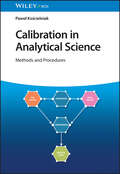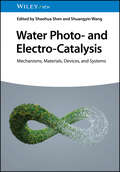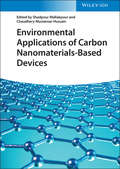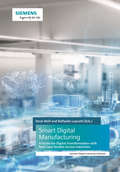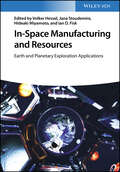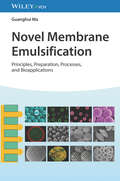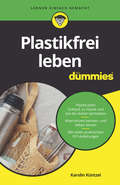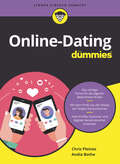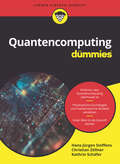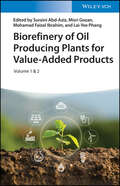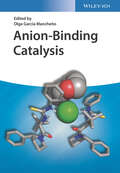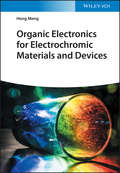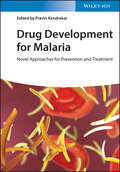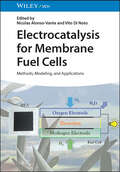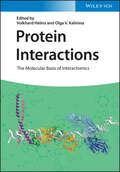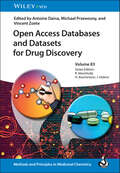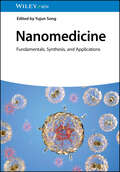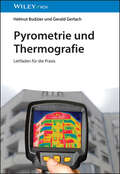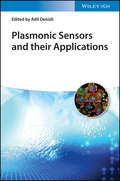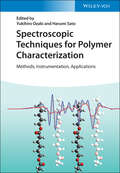- Table View
- List View
Calibration in Analytical Science: Methods and Procedures
by Paweł KościelniakCalibration in Analytical Science Designed to help analytical chemists save time and money by selecting the best calibration method in a quality control, substance monitoring, or research setting Univariate analytical calibration is a vital step in every chemical procedure that involves determining the identity or concentration of a particular substance. Depending on the type of instrument and measurement, analytical chemists need to follow different calibration strategies and protocols to ensure their instruments yield accurate readings. Calibration in Analytical Science systematically classifies and describes a wide range of calibration methods and procedures based on mathematical and empirical models for use in qualitative and quantitative analysis. Focusing on the chemical aspects of analytical calibration, this much-needed reference uses a set of equipment-independent terms and definitions that are easily transferable to the calibration strategies of any analytical process. The theoretical basis for calibration of each analytical mode is described and applied to common analytical tasks of increasing levels of difficulty and complexity. Throughout the book, the author illustrates how to combine different calibration approaches to create new calibration strategies with extended capabilities. Describes different calibration methods and procedures for determining the nature and quantity of sample components in different ways Classifies various calibration methods in both qualitative and quantitative analysis Demonstrates how the random and systematic errors of an analytical method can be minimized by the proper calibration strategy Discusses current theoretical and methodological questions in calibration research Highlights how calibration approaches can diagnose, evaluate, and eliminate analytical errors Includes a concluding chapter on the contribution of calibration to the greening of analytical chemistry Calibration in Analytical Science: Methods and Procedures is a must-have reference for analytical chemists working in academia and industry, chemists of various specialties involved in chemical analysis, and advanced undergraduate and graduate students taking courses in advanced analytical chemistry.
Membrane Contactor Technology: Water Treatment, Food Processing, Gas Separation, and Carbon Capture
by Mohammad Younas Mashallah RezakazemiAn eye-opening exploration of membrane contactors from a group of industry leaders In Membrane Contactor Technology: Water Treatment, Food Processing, Gas Separation, and Carbon Capture, an expert team of researchers delivers an up-to-date and insightful explanation of membrane contactor technology, including transport phenomena, design aspects, and diverse process applications. The book also includes explorations of membrane synthesis, process, and module design, as well as rarely discussed process modeling and simulation techniques. The authors discuss the technical and economic aspects of this increasingly important technology and examine the geometry, flow, energy and mass transport, and design aspects of membrane contactor modules. They also cover a wide range of application opportunities for this technology, from the materials sciences to process engineering. Membrane Contactor Technology also includes: A thorough introduction to the membrane contactor extraction process, including dispersion-free membrane extraction processes and supported liquid membrane processes Comprehensive explorations of membrane transport theory, including discussions of diffusional mass and heat transfer modeling, as well as numerical modeling In-depth examinations of module configuration and geometry, including design and flow configuration Practical discussions of modes or operation, including membrane distillation, osmotic evaporation, and forward osmosis Perfect for process engineers, biotechnologists, water chemists, and membrane scientists, Membrane Contactor Technology also belongs in the libraries of chemical engineers, polymer chemists, and chemists working in the environmental industry.
Water Photo- and Electro-Catalysis: Mechanisms, Materials, Devices, and Systems
by Shaohua Shen Shuangyin WangWater Photo- and Electro-Catalysis Introduce yourself to the cutting-edge processes of water photo- and electro-catalysis with this important guide Photocatalysis and electrocatalysis reactions involving water are becoming an increasingly important component of energy and sustainability research. Water electrocatalysis and photo-electrocatalysis promise to have a significant impact on human energy production and its by-products, and to play a substantial role in solutions to global energy and environmental crises. Familiarity with these processes will be critical for sustainable energy production in the coming years. Water Photo- and Electro-Catalysis provides a detailed and readable introduction to these processes and their attendant technologies. It covers mechanisms, materials, and devices that catalyze water-based energy conversion, as well as introducing the theoretical principles that are driving the development of new technologies in this area. The result is an essential book for researchers and materials scientists in a range of fields. Water Photo- and Electro-Catalysis readers will also find: An editorial team with decades of combined experience in energy and materials science researchDetailed treatment of electrocatalysis processes for hydrogen evolution (HER), oxygen/hydrogen peroxide evolution (OER/HPER), and moreAnalysis of mechanisms including heterogenous vs. homogenous photocatalysis, electrodes-based photo-electrocatalysis, and photovoltaic-electrocatalysis Water Photo- and Electro-Catalysis is a valuable reference for catalytic chemists, materials scientists, energy chemists, and all research and industry professionals in photo(electro)catalysis and sustainable energy fields.
Environmental Applications of Carbon Nanomaterials-Based Devices
by Shadpour MallakpourEnvironmental Applications of Carbon Nanomaterials-Based Devices Explore this insightful treatment of the function and fabrication of high-performance devices for environmental applications Environmental Applications of Carbon Nanomaterials-Based Devices delivers an overview of state-of-the-art technology in functionalized carbon nanomaterials-based devices for environmental applications. The book provides a powerful foundation, based in materials science, on functionalized carbon nanomaterials in general, and environmental science and device fabrication in particular. The book focuses on the chemical and physical methods of functionalization of carbon nanomaterials and the technology of device fabrication, including lab-on-a-chip approaches and applications such as wastewater purification and gas sensing. It provides readers with a thorough understanding of effective environmental remediation techniques performed with carbon nanomaterials-based devices. In addition to topics such as cross-linked graphene oxide membranes assembled with graphene oxide nanosheets, free-standing graphene oxide-chitin nanocrystal composite membranes for dye adsorption and oil/water separation, and in-situ grown covalent organic framework nanosheets on graphene for membrane-based dye/salt separation, readers will also benefit from the inclusion of: A thorough introduction to charge-gated ion transport through polyelectrolyte intercalated amine reduced graphene oxide membranes An exploration of hydrotalcite/graphene oxide hybrid nanosheets functionalized nanofiltration membrane for desalination A discussion of the incorporation of attapulgite nanorods into graphene oxide nanofiltration membranes for efficient dyes wastewater treatment An examination of attapulgite nanofibers and graphene oxide composite membranes for high-performance molecular separation Perfect for materials scientists, analytical chemists, and environmental chemists, Environmental Applications of Carbon Nanomaterials-Based Devices will also earn a place in the libraries of sensor developers seeking a one-stop resource for high-performance devices and sensors useful for environmental applications.
Smart Digital Manufacturing: A Guide for Digital Transformation with Real Case Studies Across Industries
by Rene WolfThe world progresses toward Industry 4.0, and manufacturers are challenged to successfully navigate this unique digital journey. To some, digitalization is a golden opportunity; to others, it is a necessary evil. But to optimist and pessimist alike, there is a widespread puzzlement over the practical details of digitalization. To many manufacturers, digital transformation is a vague and confusing concept they nevertheless must grapple with in order to survive the Fourth Industrial Revolution. The proliferation of digital manufacturing technologies adds to the confusion, leaving many manufacturers perplexed and unprepared, with little real insight into how emerging technologies can help them sustain a competitive edge in their markets. This book effectively conveys Siemens's knowledge and experience through a concept called "Smart Digital Manufacturing," a stepwise approach to realizing the promise of the Fourth Industrial Revolution. The Smart Digital Manufacturing roadmap provides guidance and enables low-risk, high-reward adoption of new manufacturing software technologies through a series of tipping-point investment decisions that result in optimized manufacturing performance. The book provides readers with a clear understanding of what digital technology has to offer them, and how and when to invest in these essential components of tomorrow?s factories. René Wolf is Senior Vice President of Manufacturing Operations Management Software for Siemens Digital Industries Software, a business unit of the Siemens Digital Factory Division. Raffaello Lepratti is Vice President of Business Development and Marketing for Siemens Digital Industries Software.
In-Space Manufacturing and Resources: Earth and Planetary Exploration Applications
by Volker Hessel Jana Stoudemire Hideaki Miyamoto Ian D. FiskIn-Space Manufacturing and Resources Comprehensive resource covering all in-space manufacturing and planetary resource exploration endeavors. The space economy is developing quickly, and pivotal events have brought us to a strong inflection point. This unique book includes fundamental and ground-breaking innovations in the field and is meant to quickly get readers up to speed on many different facets of space and planetary resource exploration, such as: Space health & medicine Space biology & space farming Space chemistry & space mining Space construction & advanced materials production Space policy, law & economics Presenting a snapshot of the expanding space economy and manufacturing applications in low-Earth orbit, along with resource utilization capabilities in development for Moon and Mars missions, this an indispensable source for all researchers and commercial companies working on space and planetary resource exploration.
Redox-Active Ligands: Concepts and Catalysis
by Marine Desage-El MurrRedox-Active Ligands Authoritative resource showcasing a new family of ligands that can lead to better catalysts and promising applications in organic synthesis Redox-Active Ligands gives a comprehensive overview of the unique features of redox-active ligands, describing their structure and synthesis, the characterization of their coordination complexes, and important applications in homogeneous catalysis. The work reflects the diversity of the subject by including ongoing research spanning coordination chemistry, organometallic chemistry, bioinspired catalysis, proton and electron transfer, and the ability of such ligands to interact with early and late transition metals, lanthanides, and actinides. The book is divided into three parts, devoted to introduction and concepts, applications, and case studies. After the introduction on key concepts related to the field, and the different types of ligands and complexes in which ligand-centered redox activity is commonly observed, mechanistic and computational studies are described. The second part focuses on catalytic applications of redox-active complexes, including examples from radical transformations, coordination chemistry and organic synthesis. Finally, case studies of redox-active guanidine ligands, and of lanthanides and actinides are presented. Other specific sample topics covered include: An overview of the electronic features of redox-active ligands, covering their historical perspective and biological backgroundThe versatility and mode of action of redox-active ligands, which sets them apart from more classic and tunable ligands such as phosphines or N-heterocyclic carbenesPreparation and catalytic applications of complexes of stable N-aryl radicals Metal complexes with redox-active ligands in H+/e- transfer transformations By providing up-to-date information on important concepts and applications, Redox-Active Ligands is an essential reading for researchers working in organometallic and coordination chemistry, catalysis, organic synthesis, and (bio)inorganic chemistry, as well as newcomers to the field.
Novel Membrane Emulsification: Principles, Preparation, Processes, and Bioapplications
by Guanghui MaNovel Membrane Emulsification Comprehensive resource presenting state-of-the-art of membrane emulsification technology, from principle to practice, with focus on biomedical applications Novel Membrane Emulsification: Principles, Preparation, Processes, and Bioapplications provides comprehensive coverage of membrane emulsification technology by summarizing the principle, preparation, and bioapplications through utilizing uniform particle size, introducing recent development in preparation and applications in the controlled release and delivery of protein/peptide, anticancer drugs and vaccines, and in the bioseparation media and cell culture carriers, and discussing direct, rapid, and rotary membrane emulsification equipments. Novel Membrane Emulsification includes information on: Preparation of hydrophobic microspheres from O/W emulsion, hydrophilic microspheres from W/O emulsion, and microcapsules/composite microspheres from double emulsions, covering preparation from monomer and preformed polymer systems Preparation of small particles by rapid membrane emulsification process Applications of uniform particles in sustained release of protein/peptide drugs, covering strategies to improve encapsulation efficiency and maintain bioactivity of drugs Applications of uniform particles in anticancer drug and vaccine delivery including personalized therapeutic vaccine Applications of uniform particles in protein separation, covering uniform agarose microsphere for protein separation and super-porous microsphere for vaccine separation Novel Membrane Emulsification is an essential resource for scientists and researchers in multiple fields, particularly chemistry, chemical engineering, and materials science, to advance this technique and produce novel materials with controlled characteristics. The text is also a valuable learning resource for biomedical science and bioengineering researchers and students.
Plastikfrei leben für Dummies (Für Dummies)
by Karolin KuntzelSind bei Ihnen die gelben Säcke und Wertstofftonnen auch immer prall gefüllt? Möchten Sie diesen Plastikmüllberg reduzieren und nachhaltiger leben? Das ist gar nicht so schwer, wie die Autorin Karolin Küntzel in diesem Buch zeigt. Lebensmittel und Shampoo gibt es auch ohne lästige Plastikverpackung und selbst für Funktionskleidung und Bodenbeläge gibt es Alternativen ohne Kunststoff. Dabei ist ein plastikfreies Leben nicht unbedingt teurer oder besonders aufwendig, wenn man weiß, welche "Ersatzprodukte" es gibt und wo man sie bekommt. Beginnen Sie bei den kleinen Dingen und kaufen Sie beispielsweise loses Obst und Gemüse ein. Gehen Sie in Ihrem eigenen Tempo Schritt für Schritt voran und verbannen Sie nach und nach immer mehr Plastik aus Ihrem Haushalt. Ihr ökologischer Fußabdruck wird es Ihnen danken.
Online-Dating für Dummies (Für Dummies)
by Chris Pleines Andia BotheOnline-Dating boomt. Die wenigsten Singles lernen sich heutzutage noch in einer Bar kennen. Allein in Deutschland sind jeden Monat weit über 12 Millionen Singles online auf Partnersuche. Wo und wie findet man da aber, was man wirklich sucht? Und wie sticht man aus der Masse der Singles hervor? Wo finde ich den richtigen Partner für mein Alter, meinen Typ und meine Interessen und Absichten - ob langfristige Beziehung, Flirt oder doch nur Sex? Und wie kann ich sicher daten? Die beiden Dating-Experten Chris Pleines und Andia Bothe führen Sie umfassend durch die digitale Dating-Welt von heute (und morgen).
Quantencomputing für Dummies (Für Dummies)
by Hans-Jurgen Steffens Christian Zöllner Kathrin SchäferQuantencomputing könnte die Informatik wie wir sie heute kennen revolutionieren. Die Möglichkeiten dieser Technologie sind enorm. Aber was steckt eigentlich dahinter? Mit diesem Buch führen Sie die Autoren so verständlich wie möglich in dieses komplexe Thema ein. Sie erklären Ihnen was es mit dem Quantencomputing überhaupt auf sich hat und erläutern die mathematischen und physikalischen Modelle, die ihm zugrunde liegen. Sie vergleichen Quantencomputing mit der aktuellen Informatik und werfen einen Blick darauf welche Anwendungen dadurch schon bald und welche in der weiteren Zukunft denkbar sind.
Biorefinery of Oil Producing Plants for Value-Added Products
by Suraini Abd-Aziz Misri Gozan Mohamad Faizal Ibrahim Lai-Yee PhangBiorefinery of Oil Producing Plants for Value-Added Products An instructive and up-to-date pretreatment and industrial applications of oil producing plants Biorefinery of Oil Producing Plants for Value-Added Products is a two-volume set that delivers a comprehensive exploration of oil producing plants, from their availability to their pretreatment, bioenergy generation, chemical generation, bioproduct generation, and economic impact. The distinguished team of editors has included a wide variety of highly instructive resources written by leading contributors to the field. This set explores the current and future potential of bioenergy production to address the energy and climate crisis, as well as the technologies used to produce materials like biogas, biodiesel, bioethanol, biobutanol, biochar, fuel pellets, and biohydrogen. It also discusses the production of biobased chemicals, including bio-oil, biosurfactants, catanionic surfactants, glycerol, biovanillin, bioplastic, and plant-oil based polyurethanes. Concluding with an insightful analysis of the economic effects of oil producing plants, the set also offers readers: A thorough introduction to the availability of oil producing plants, including palm oil, castor oil, jatropha, nyamplung, and coconut A comprehensive exploration of the pretreatment of oil producing plants, including the physical, chemical and biological pretreatment of lignocellulosic biomass Practical discussion of the generation of bioenergy, including biogas generation in the palm oil mill and biodiesel production techniques using jatropha In-depth examinations of the generation of biobased chemicals, including those produced from the tobacco plant Perfect for researchers and industry practitioners involved with the biorefinery of oil producing plants, Biorefinery of Oil Producing Plants for Value-Added Products also belongs in the libraries of undergraduate and graduate students studying agriculture, chemistry, engineering, and microbiology.
Taschenatlas der Analytik
by Georg SchwedtDer Taschenatlas bietet eine kompakte Einführung und Übersicht über Grundlagen und Anwendungen der Analytischen Chemie. Dabei sind jeweils erläuternder Text und eine Farbtafel auf einer Doppelseite gegenübergestellt. Das Buch enthält insgesamt 125 Farbtafeln, die die gesamte Breite der modernen Analytik in Chemie, Biowissenschaften und Teilen von Physik und Materialwissenschaften abdecken. Für die vierte Auflage wurde der Taschenatlas erweitert und auf den aktuellen Stand gebracht. Er enthält u. a. acht neue Farbtafeln zu aktuellen Themen wie Mikroextraktionstechniken, Radioimmunoassays, Superfluid-Chromatographie und die elektronenmikroskopische Untersuchung von Materialoberflächen. Mit diesem Atlas sind die Grundlagen aller wichtigen analytischen Verfahren immer griffbereit - ideal zum raschen Nachlesen und für die Prüfungsvorbereitung.
Einführung in die Wasserchemie
by Georg SchwedtEinführung in die Wasserchemie Eine leicht verständliche Übersicht zu Wasser in all seinen Erscheinungsformen und deren Bedeutung für Mensch und Natur Diese Einführung vermittelt ein umfassendes Bild der Ressource Wasser, angefangen vom natürlichen Wasserkreislauf und den zahlreichen Stoffkreisläufen, die daran gekoppelt sind, über die verschiedenen Wasserarten und deren Inhaltsstoffe bis hin zur Analyse und technischen Aufbereitung von Wasser für die Nutzung durch den Menschen. Der Autor versteht es dabei, die geologischen, chemischen, biologischen, technologischen und rechtlichen Aspekte der Wassernutzung im Zusammenhang darzustellen. Ein Schwerpunkt des Buches liegt auf den Wasserinhaltsstoffen und deren Nachweis in den unterschiedlichen Wasserarten, vom Trinkwasser bis zum Abwasser und vom Grundwasser bis zum Meerwasser. Gängige Verfahren der Aufbereitung und Reinigung von Wasser werden ebenso erläutert wie die Anforderungen an Heil- und Mineralwässer. Dieses Grundlagenbuch ist ein perfekter Einstieg für alle, die sich in Ausbildung und Beruf mit dem Thema Wasser befassen und mehr über seine Herkunft und sein Verhalten erfahren möchten.
Anion-Binding Catalysis
by Olga García MancheñoExplores the potential of new types of anion-binding catalysts to solve challenging synthetic problems Anion-Binding Catalysis introduces readers to the use of anion-binding processes in catalytic chemical activation, exploring how this approach can contribute to the future design of novel synthetic transformations. Featuring contributions by world-renowned scientists in the field, this authoritative volume describes the structure, properties, and catalytic applications of anions as well as synthetic applications and practical analytical methods. In-depth chapters are organized by type of catalyst rather than reaction type, providing readers with an accessible overview of the existing classes of effective catalysts. The authors discuss the use of halogens as counteranions, the combination of (thio)urea and squaramide-based anion-binding with other types of organocatalysis, anion-binding catalysis by pnictogen and tetrel bonding, nucleophilic co-catalysis, anion-binding catalysis by pnictogen and tetrel bonding, and more. Helping readers appreciate and evaluate the potential of anion-binding catalysis, this timely book: Illustrates the historical development, activation mode, and importance of anion-binding in chemical catalysis Explains the analytic methods used to determine the anion-binding affinity of the catalysts Describes catalytic and synthetic applications of common NH- and OH-based hydrogen-donor catalysts as well as C-H triazole/triazolium catalysts Covers amino-catalysis involving enamine, dienamine, or iminium activation approaches Discusses new trends in the field of anion-binding catalysis, such as the combination of anion-binding with other types of catalysis Presenting the current state of the field as well as the synthetic potential of anion-binding catalysis in future, Anion-Binding Catalysis is essential reading for researchers in both academia and industry involved in organic synthesis, homogeneous catalysis, and pharmaceutical chemistry.
Organic Electronics for Electrochromic Materials and Devices
by Hong MengExplore this comprehensive overview of organic electrochromic materials and devices from a leading voice in the industry Organic Electronics for Electrochromic Materials and Devices delivers a complete discussion of the major and key topics related to the phenomenon of electrochromism. The text covers the history of organic electrochromism, its fundamental principles, different types of electrochromic materials, the development of device structures and multi-function devices, characterizations of device performance, modern applications of electrochromic devices, and prospects for future electrochromic devices. The distinguished author places a strong focus on recent research results from universities and private firms from around the world and addresses the issues and challenges faced by those who apply organic electrochromic technology in the real world. With these devices quickly becoming the go-to display technology in the field of electronic information, this resource will quickly become indispensable to all who work or study in the field of optics. Readers will also benefit from the inclusion of: A thorough introduction to organic electrochromism, including its history and the mechanisms of electrochromic devices An exploration of polymer electrolytes for electrochromic applications, including their requirements and types A discussion of electrochromic small molecules, including the development of technology in conjugated polymer and violene-cyanine hybrids A treatment of Prussian blue and metallohexacyanates, including their backgrounds, technology development, crystal structures, synthesis, nanocomposites, and assembled electrochromic devices Perfect for materials scientists, polymer chemists, organic chemists, physical chemists, and inorganic chemists, Organic Electronics for Electrochromic Materials and Devices will also earn a place in the libraries of physicists and those who work in the optical industry who seek a one-stop reference that covers all aspects of organic electrochromic materials.
Drug Development for Malaria: Novel Approaches for Prevention and Treatment
by Pravin KendrekarDrug Development for Malaria Provides readers with first-hand advice for the development of novel antimalarial drugs This book provides a systematic overview of antimalarial drug development and presents a wealth of data and insight from drug developers across three continents, including many from countries where the disease is endemic. Throughout, the contributions have been written with the drug developer in mind, highlighting challenges but also opportunities for the successful development of effective antimalarial drugs. Case studies and method-oriented chapters provide an abundance of practical first-hand advice on how to successfully develop an antimalarial drug. Key topics covered in the book include: The performance of current drugs and therapies, the influence of formulation and targeted delivery, and strategies to overcome drug resistance. Technologies and approaches for development of novel drugs, such as assays, computer-aided drug design, known and potential drug targets, and natural sources for novel antimalarial compounds Vaccination as an alternative to drug therapy For chemists and other professionals working in industries related to medicine and pharmaceuticals, this book provides a completely comprehensive overview of the current state of novel antimalarial drugs and how they can be developed in an efficient and cost-effective manner.
Electrocatalysis for Membrane Fuel Cells: Methods, Modeling, and Applications
by Nicolas Alonso-Vante Vito Di NotoElectrocatalysis for Membrane Fuel Cells Comprehensive resource covering hydrogen oxidation reaction, oxygen reduction reaction, classes of electrocatalytic materials, and characterization methods Electrocatalysis for Membrane Fuel Cells focuses on all aspects of electrocatalysis for energy applications, covering perspectives as well as the low-temperature fuel systems principles, with main emphasis on hydrogen oxidation reaction (HOR) and the oxygen reduction reaction (ORR). Following an introduction to basic principles of electrochemistry for electrocatalysis with attention to the methods to obtain the parameters crucial to characterize these systems, Electrocatalysis for Membrane Fuel Cells covers sample topics such as: Electrocatalytic materials and electrode configurations, including precious versus non-precious metal centers, stability and the role of supports for catalytic nano-objects; Fundamentals on characterization techniques of materials and the various classes of electrocatalytic materials; Theoretical explanations of materials and systems using both Density Functional Theory (DFT) and molecular modelling; Principles and methods in the analysis of fuel cells systems, fuel cells integration and subsystem design. Electrocatalysis for Membrane Fuel Cells quickly and efficiently introduces the field of electrochemistry, along with synthesis and testing in prototypes of materials, to researchers and professionals interested in renewable energy and electrocatalysis for chemical energy conversion.
Introduction to Adhesive Bonding
by Lucas Filipe da Silva Eduardo Andre Marques Ana Sofia Barbosa Ricardo Joao Carbas Alireza Akhavan-SafarIntroduction to Adhesive Bonding A step-by-step introduction to basic principles and practical applications of adhesive bonding, designed for students and professionals alike Adhesive bonding—the process of joining two surfaces using glues, epoxies, plastic agents, and other adhesives—is a major technique with wide applications in industries as a diverse as aerospace, footwear manufacturing, and food packaging. Adhesive bonding holds several advantages over conventional joining techniques, such as uniform stress concentrations, protection of the bonded surfaces or joints, and the ability to join a variety of different materials and irregular surfaces. Introduction to Adhesive Bonding provides an accessible overview of the principles and common applications of adhesive bonding. Using a systematic approach, the authors thoroughly explain each step necessary to achieve a successful adhesive bond, including surface preparation, bonding agent selection, design and construction of bonded joints, health and safety considerations, and quality control. Readers are provided with both the theoretical foundation and practical information required to plan and complete their own adhesive bonding projects. This comprehensive yet reader-friendly volume: Highlights the inherent advantages of adhesive bonding in various applicationsDescribes the use of adhesive bonding in the development of novel and advanced projects in different industriesFeatures numerous real-world examples of adhesive bonding in areas such as the transportation industry, civil engineering, medical applications, and sports equipmentDiscusses how adhesives enable development of new products and constructions of reduced weight and sizeIdentifies important limitations and durability concerns of the use of adhesives in specific applications Introduction to Adhesive Bonding is an ideal textbook for undergraduate or graduate Engineering and Chemistry programs, and a useful reference for researchers and industry professionals working in fields such as Engineering, Surface and Polymer Chemistry, and Materials Science.
Protein Interactions: The Molecular Basis of Interactomics
by Volkhard HelmsProtein Interactions A fundamental guide to the burgeoning field of protein interactions From enzymes to transcription factors to cell membrane receptors, proteins are at the heart of biological cell function. Virtually all cellular processes are governed by their interactions, with one another, with cell bodies, with DNA, or with small molecules. The systematic study of these interactions is called Interactomics, and research within this new field promises to shape the future of molecular cell biology. Protein Interactions goes beyond any existing guide to protein interactions, presenting the first truly comprehensive overview of the field. Edited by two leading scholars in the field of protein bioinformatics, this book covers all known categories of protein interaction, stable as well as transient, as well as the effect of mutations and post-translational modifications on the interaction behavior. Protein Interactions readers will also find: Introductory chapters on protein structure, conformational dynamics, and protein-protein binding interfaces A data-driven approach incorporating machine learning and integrating experimental data into computational models An outlook on the current challenges in the field and suggestions for future research Protein Interactions will serve as a fundamental resource for novice researchers who want a systematic introduction to interactomics, as well as for experienced cell biologists and bioinformaticians who want to gain an edge in this exciting new field.
Open Access Databases and Datasets for Drug Discovery (Methods & Principles in Medicinal Chemistry)
by Raimund Mannhold Jörg Holenz Helmut BuschmannOpen Access Databases and Datasets for Drug Discovery Timely resource discussing the future of data-driven drug discovery and the growing number of open-source databases With an overview of 90 freely accessible databases and datasets on all aspects of drug design, development, and discovery, Open Access Databases and Datasets for Drug Discovery is a comprehensive guide to the vast amount of “free data” available to today’s pharmaceutical researchers. The applicability of open-source data for drug discovery and development is analyzed, and their usefulness in comparison with commercially available tools is evaluated. The most relevant databases for small molecules, drugs and druglike substances, ligand design, protein 3D structures (both experimental and calculated), and human drug targets are described in depth, including practical examples of how to access and work with the data. The first part is focused on databases for small molecules, followed by databases for macromolecular targets and diseases. The final part shows how to integrate various open-source tools into the academic and industrial drug discovery and development process. Contributed to and edited by experts with long-time experience in the field, Open Access Databases and Datasets for Drug Discovery includes information on: An extensive listing of open access databases and datasets for computer-aided drug design PubChem as a chemical database for drug discovery, DrugBank Online, and bioisosteric replacement for drug discovery supported by the SwissBioisostere database The Protein Data Bank (PDB) and macromolecular structure data supporting computer-aided drug design, and the SWISS-MODEL repository of 3D protein structures and models PDB-REDO in computational aided drug design (CADD), and using Pharos/TCRD for discovering druggable targets Unmatched in scope and thoroughly reviewing small and large open data sources relevant for rational drug design, Open Access Databases and Datasets for Drug Discovery is an essential reference for medicinal and pharmaceutical chemists, and any scientists involved in the drug discovery and drug development.
Nanomedicine: Fundamentals, Synthesis, and Applications
by Yujun SongA comprehensive and multidisciplinary guide to nanomaterials-based medicine Nanomedicine is the study and application of nanomaterials-based medical techniques. In recent years it has very rapidly become indispensable in a huge range of medical contexts, from analysis of extreme life events to diagnosis and treatment of life-threatening intractable diseases, such as cancers and cardiovascular diseases. It has already transformed both research and clinical outcomes in many areas of medicine and promises to continue as the cutting-edge research and clinical area for the next generation of medical specialists. Nanomedicine: Fundamentals, Synthesis, and Applications constitutes a comprehensive guide to this subfield and its recent advances. Beginning with a brief history of the field and introduction to its core principles, it thoroughly treats recent developments in this vital and ever-growing field. Its multidisciplinary approach equips the reader with a systematic overview of these life-saving developments in medicine. Nanomedicine readers will also find: Edited by a leading researcher with decades of experience in both North America and ChinaDetailed treatment of subjects including nanocarriers, nanomaterial bioprobes, multi-function nanodrugs, nanomedicine-mediated immunotherapy and/or physical ablation, and moreA comprehensive volume treats every facet of the subject Nanomedicine is a vital resource for biochemists, biomedical engineers, pharmaceutical chemists, physicists, and professionals in the biotechnological industries, as well as for clinicians looking to familiarize themselves with nanomedical techniques and instrumentation.
Pyrometrie und Thermografie: Leitfaden für die Praxis
by Gerald Gerlach Helmut BudzierPyrometrie und Thermografie Die Thermografie ist ein bildgebendes Verfahren, um Oberflächentemperaturen von Objekten anzuzeigen. Dies erfolgt, indem man die Intensität der Infrarotstrahlung, die von einem bestimmten Punkt ausgeht, misst und daraus die dort herrschende Temperatur berechnet. Als Messgeräte dazu werden Thermografie-Kameras verwendet. Wird die Temperatur nur an einem Punkt gemessen, spricht man von Pyrometrie, die entsprechenden Geräte werden als Pyrometer bezeichnet. Die berührungslose Temperaturmessung ist überall dort von großem Interesse, wo hohe Temperaturen auftreten, harsche Bedingungen herrschen oder der Messort nicht erreicht werden kann. Das ist zum Beispiel in der Prozessmesstechnik, in Gießereien und Stahlwerken oder der Überwachung von brandanfälligen Umgebungen (Wälder, Müllplätze) der Fall. Das Buch wendet sich an alle, die Pyrometer und Thermografie-Kameras nutzen und typischerweise mit den zu überwachenden Prozessen vertraut sind, aber oft nicht mit der einzusetzenden Messtechnik. Deshalb fokussiert es auf die Anwendung von Pyrometern und Thermografie-Kameras und macht auf übersichtliche Weise mit den Grundlagen, den Fehlereinflüssen, den Grenzen hinsichtlich der thermischen, zeitlichen und räumlichen Auflösung und der erreichbaren Messgenauigkeit vertraut.
Plasmonic Sensors and their Applications
by Adil DenizliPlasmonic Sensors and their Applications A practically-focused reference and guide on the use of plasmonic sensing as a faster and cheaper alternative to conventional sensing platforms Plasmons, the collective oscillations of electrons occurring at the interface between any two materials, are sensitive to changes in dielectric properties near metal surfaces. Plasmonic sensors enable the real-time study of unique surface properties by monitoring the effect of the material interaction at the sensor surface. Plasmonic sensing techniques offer fast, label-free analysis, and hold advantages over labelling techniques such as ELISA (enzyme-linked immunosorbent assay). Plasmonic Sensors and their Applications examines the development and use of highly sensitive and selective plasmonic sensing platforms in chemistry, biotechnology, and medicine. Contributions by an international panel of experts provide timely and in-depth coverage of both real-world applications and academic research in the dynamic field. The authors describe advances in nanotechnology, polymer chemistry, and biomedicine, explore new and emerging applications of plasmonic sensing, discuss future trends and potential research directions, and more. This authoritative volume: Demonstrates why plasmonic sensing is a profitable method for easy and label-free analysis in real-timeCovers a variety of applications of plasmonic sensors, such as disease diagnostics, vitamin detection, and detection of chemical and biological warfare agents Includes a brief introduction to the history and development of plasmonic sensorsProvides concise theory and background for every application covered in the text Plasmonic Sensors and their Applications is an invaluable resource for analytical chemists, biochemists, biotechnologists, protein and surface chemists, and advanced students of biotechnology.
Spectroscopic Techniques for Polymer Characterization: Methods, Instrumentation, Applications
by Yukihiro Ozaki|An insightful exploration of cutting-edge spectroscopic techniques in polymer characterization In Spectroscopic Techniques for Polymer Characterization: Methods, Instrumentation, Applications, a team of distinguished chemists delivers a comprehensive exploration of the vast potential of spectroscopic characterization techniques in polymer research. The book offers a concise outline of the principles, advantages, instrumentation, experimental techniques, and noteworthy applications of cutting-edge spectroscopy. Covering a wide range of polymers, from nylon to complex polymeric nanocomposites, the author presents recent developments in polymer science to polymer, analytical, and material chemists, assisting them in keeping track of the progress in modern spectroscopy. Spectroscopic Techniques for Polymer Characterization contains contributions from pioneers in modern spectroscopic techniques from around the world. The included materials bridge the gap between spectroscopists, polymer scientists, and engineers in academia and industry. The book also offers: A thorough introduction to the progress in spectroscopic techniques, including polymer spectroscopy and near-infrared spectroscopy Comprehensive explorations of topical polymers studied by spectroscopy, including polymer thin films, fluoropolymers, polymer solutions, conductive polymers Practical discussions of infrared imaging, near-infrared imaging, two-dimensional correlation spectroscopy, and far-ultraviolet spectroscopy In-depth examinations of spectroscopic studies of weak hydrogen bonding in polymers Spectroscopic Techniques for Polymer Characterization: Methods, Instrumentation, Applications is a must-read reference for polymer, analytical, and physical chemists, as well as materials scientists and spectroscopists seeking a one-stop resource for polymer characterization using spectroscopic analyses.
